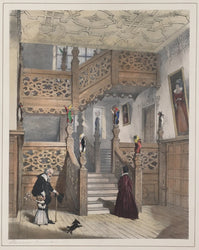Joseph Nash (1809-1878). “Staircase.” [Crewe Hall, Cheshire]. From Mansions of England in the Olden Time.
London: C. Hullmandel, 1839-41. Approx. 12 x 16. Deluxe tinted lithographs with original hand coloring. Print margins trimmed to image and mounted to backing board as originally issued. Very good condition.
Joseph Nash (1809-1878) subtitled this formidable work on Tudor (16th-century) domestic architecture as “depicting the most characteristic features of the domestic architecture of the Tudor Age, and also illustrating the costumes, habits, and recreations of our ancestors.” Nash was a draughtsman and lithographer of architectural views, trained by A. C. Pugin. He preferred a freer, more atmospheric style to that of his mentor. Here Nash was a perfect partner for C. J. Hullmandel, the famous British lithographer who experimented successfully with new processes, most notably the “lithotint” process, which he named and patented in 1840. This technique, allowing for greater nuance and value gradation than pure lithography, was an ideal means of expression for Nash’s historically rich and picturesque depictions of Tudor mansions.
Interested very much in interiors, Nash lavished his attention on historical detail for these prints, taking care that all furniture, decoration and costume were appropriate to the period of the mansion. The aristocratic ladies and gentlemen who move through the rooms of his great houses (including Henry VIII and Queen Elizabeth I) were taken directly from the portraits on the walls. The skillful lithography allows for maximum warmth, richness and convincing movement, leaving us prints that are excellent examples of mid-nineteenth-century British architectural views, when more romantic and anecdotal images supplanted the topographical renderings of the eighteenth century. These prints by Nash are both wonderful enticements for the imagination, and fascinating historical documents.
Ref.: Simon Houfe, The Dictionary of British Book Illustrators and Caricaturists 1800-1914. Woodbridge, Suffolk; 1981. Pp. 42-43.

![Nash, Joseph "Staircase.” [Crewe Hall, Cheshire]](http://philaprintshop.com/cdn/shop/files/nashcrewec_{width}x.jpg?v=1682625327)
![Nash, Joseph "Staircase.” [Crewe Hall, Cheshire]](http://philaprintshop.com/cdn/shop/files/nashcrewe_{width}x.jpg?v=1682625332)
![Load image into Gallery viewer, Nash, Joseph "Staircase.” [Crewe Hall, Cheshire]](http://philaprintshop.com/cdn/shop/files/nashcrewec_110x110@2x.jpg?v=1682625327)
![Load image into Gallery viewer, Nash, Joseph "Staircase.” [Crewe Hall, Cheshire]](http://philaprintshop.com/cdn/shop/files/nashcrewe_110x110@2x.jpg?v=1682625332)
